|
|
|
Sort Order |
|
|
|
Items / Page
|
|
|
|
|
|
|
| Srl | Item |
| 1 |
ID:
130865
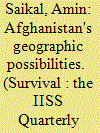

|
|
|
|
|
| Publication |
2014.
|
| Summary/Abstract |
Afghanistan's geostrategic potential is hampered by domestic weakness, regional tensions and major-power competition. Historically, Afghanistan's position at the junction between Asia and Europe has not only made it susceptible to outside invasions and influence, but also rendered it an important conduit for cross-continental interactions. The Greco-Bactrian (250-150 BCE), Kushan (30-375 AD) and Sassanid (224-651 AD) empires derived much of their wealth from the Silk Road, a series of interlinked trading networks criss-crossing the Eurasian land mass and centred around what is now known as Afghanistan. These routes served as the main arteries of east-west trade and transportation, until the disintegration of the Mongol Empire in 1368 AD effectively dismantled the network.
|
|
|
|
|
|
|
|
|
|
|
|
|
|
|
|
| 2 |
ID:
091610
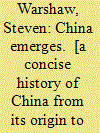

|
|
|
|
|
| Edition |
11th Rev ed.
|
| Publication |
Berkeley, Diablo Press, 1998.
|
| Description |
ix, 252p.pbk
|
| Standard Number |
0872970019
|
|
|
|
|
|
|
|
|
|
|
|
Copies: C:1/I:0,R:0,Q:0
Circulation
| Accession# | Call# | Current Location | Status | Policy | Location |
| 054467 | 951/WAR 054467 | Main | On Shelf | General | |
|
|
|
|
| 3 |
ID:
049086
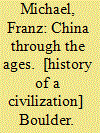

|
|
|
|
|
| Publication |
Boulder, Westview Press, 1986.
|
| Description |
xviii, 278p.pbk
|
| Standard Number |
0865317267
|
|
|
|
|
|
|
|
|
|
|
|
Copies: C:1/I:0,R:0,Q:0
Circulation
| Accession# | Call# | Current Location | Status | Policy | Location |
| 039813 | 951/MIC 039813 | Main | On Shelf | General | |
|
|
|
|
| 4 |
ID:
184155
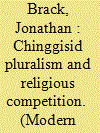

|
|
|
|
|
| Summary/Abstract |
This article argues that the Mongol empire's famous religious tolerance cannot be explained solely through its adoption of Inner Asian imperial political traditions of ruling over ethnically and religiously diverse subjects. Instead, this pluralism can be ascribed to a wider religious pattern of the Mongols. The first part argues that the analytical category of immanentist religions explains not only the inter-cultic transparency exhibited by the Mongol courts, but also the few explicit instances where the Chinggisid rulers reacted with ‘religious’ violence. The article further explores the strategies employed by the religious vectors, mainly Buddhists and Muslims, to address, accommodate, and subvert the Chinggisids’ patterns of religiosity and primarily their pluralism, and the Mongols’ deified mode of sacralizing kingship. Focusing on the Mongol-Ilkhanid court in Iran, the article examines how religious representatives used conceptual affinities and equivalences between the Mongol traditions and certain principles of their own religious frameworks to gain influence and favour, and persuade the khans to convert or retain their earlier commitment to the new religious affiliation. Employing this assimilative approach, they manoeuvred within the religious, immanentist paradigm of their nomadic patrons while moulding and manipulating it to their own religious, transcendentalist ends. The article further demonstrates how this ‘translation’ process of Chinggisid patterns became an arena of Buddhist–Muslim rivalry and competition, but also cross-cultural fertilization.
|
|
|
|
|
|
|
|
|
|
|
|
|
|
|
|
| 5 |
ID:
184811
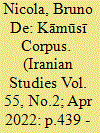

|
|
|
|
|
| Summary/Abstract |
The arrival of the Mongols in Iran in the thirteenth century made a deep impact on the political, economic, and religious life of the region. With the establishment of the Ilkhanate (1250–1335), the cultural life of Iran was also transformed. The territories under Mongol control saw the appearance of new architectural styles, a renaissance of Persian literature, and a burst in the production of Islamic manuscripts. Regarding this literary production, scholars have concentrated their efforts on studying important works composed in Mongol Iran either for their scientific, literary, or artistic value. However, most of this research focuses on individual manuscripts or specific works belonging to a concrete literary genre; these do not provide a holistic picture of the production, distribution, and consumption of the huge number of manuscripts surviving from the period. In an attempt to contribute to a more comprehensive understanding of this phenomenon, this study looks at six different manuscripts, jointly referred to as the “Kāmūsī corpus,” that share the rare characteristic of having all been copied by the same hand in fourteenth-century Iran. This article investigates the individuals involved in the production of these manuscripts, identifies the different works included in this corpus, and connects the production of these texts and the dissemination of knowledge in Ilkhanid Iran.
|
|
|
|
|
|
|
|
|
|
|
|
|
|
|
|
| 6 |
ID:
060917
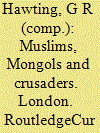

|
|
|
|
|
| Publication |
London, routledgeCurzon, 2005.
|
| Description |
xxvi, 282p.hbk
|
| Standard Number |
070071393X
|
|
|
|
|
|
|
|
|
|
|
|
Copies: C:1/I:0,R:0,Q:0
Circulation
| Accession# | Call# | Current Location | Status | Policy | Location |
| 049588 | 956.014/HAW 049588 | Main | On Shelf | General | |
|
|
|
|
| 7 |
ID:
169268
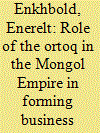

|
|
|
|
|
| Summary/Abstract |
This study investigates the emergence and development of business partnerships established by the Mongols and their merchant partners, ortoqs, in the Middle Ages. Ortoqs are known to have conducted trade and money-lending with the capital invested by their partners. This study shows that the contractual arrangements of Mongol–ortoq partnerships closely resembled medieval partnership contracts, such as mudharaba, inan, societas and commenda. Sophisticated concepts of liability in relation to investments and loans were developed in Mongol–ortoq partnerships, promoting trade and investment to facilitate the commercial integration of the Mongol Empire.
|
|
|
|
|
|
|
|
|
|
|
|
|
|
|
|
| 8 |
ID:
184154
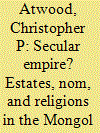

|
|
|
|
|
| Summary/Abstract |
Recent work in religious studies has emphasized how European colonial empires used the defining and constructing of religions and secularism as tools of rule. This article explores parallel processes in the Mongol empire (1206–1368) where ‘religion-making’ occurred in three areas: 1) a precise and legal definition of professional service estates among the conquered peoples that included the clergies of designated religions; 2) a broad and imprecise classification of nom or ‘way of life’ that partially overlapped with the clergies defined in the first category; and 3) a realm above all such sectarian distinctions destined for the Mongol ruling elite who alone were capable of living in free obedience to Heaven. The parallels and differences with classifications of the religious and the secular in European colonial empires shed light on how power interacts with cultural classification and practices.
|
|
|
|
|
|
|
|
|
|
|
|
|
|
|
|
| 9 |
ID:
048073
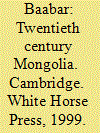

|
|
|
|
|
| Publication |
Cambridge, The White Horse Press, 1999.
|
| Description |
xiv, 448p.pbk
|
| Standard Number |
1874267413
|
|
|
|
|
|
|
|
|
|
|
|
Copies: C:1/I:0,R:0,Q:0
Circulation
| Accession# | Call# | Current Location | Status | Policy | Location |
| 042440 | 951.7/BAA 042440 | Main | On Shelf | General | |
|
|
|
|
|
|
|
|
|